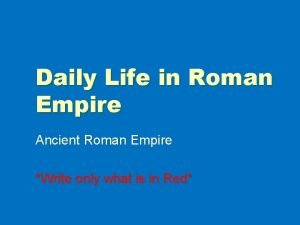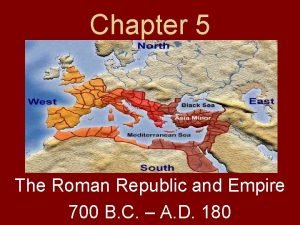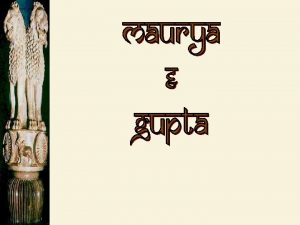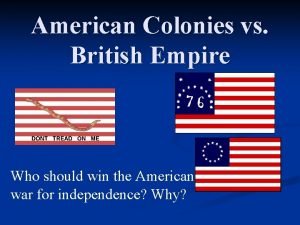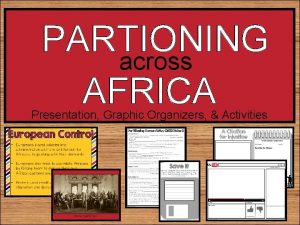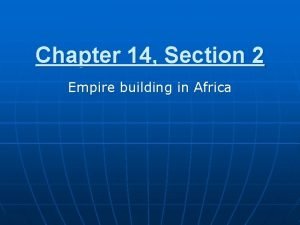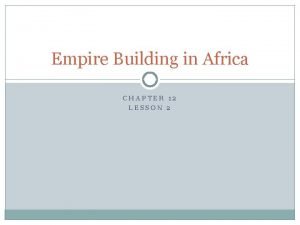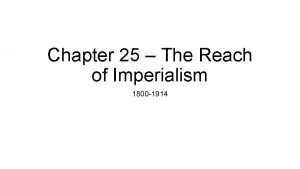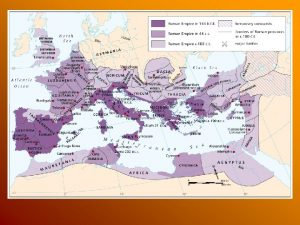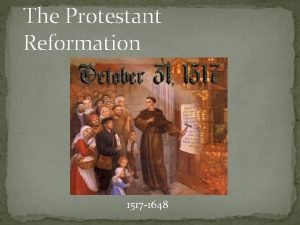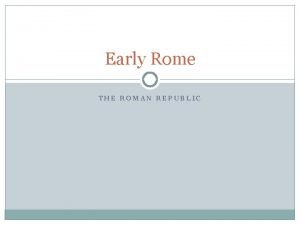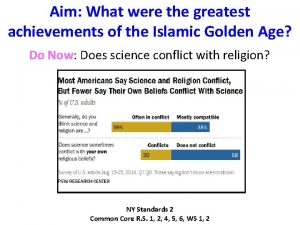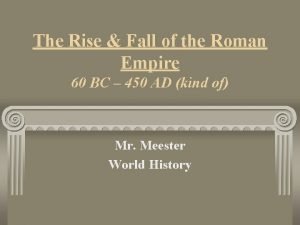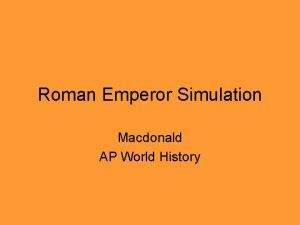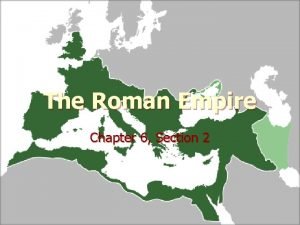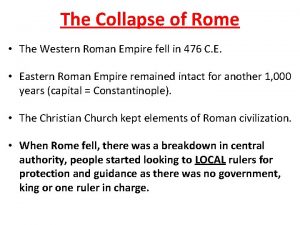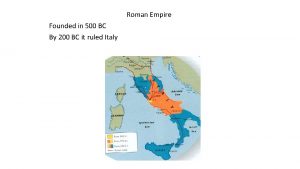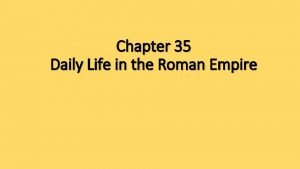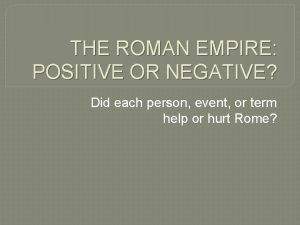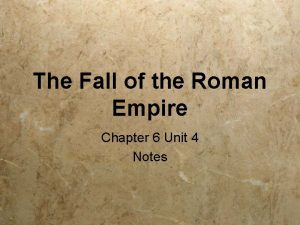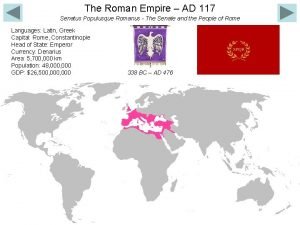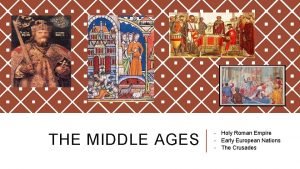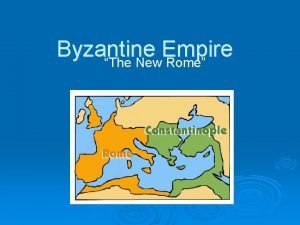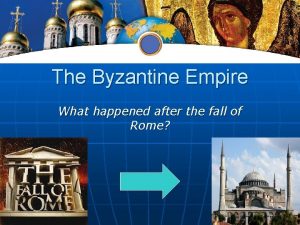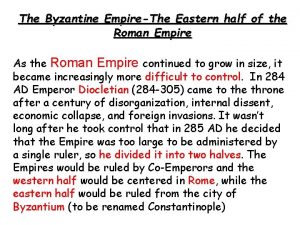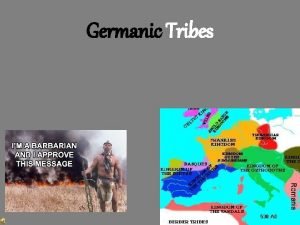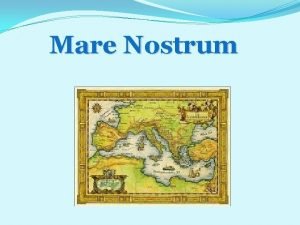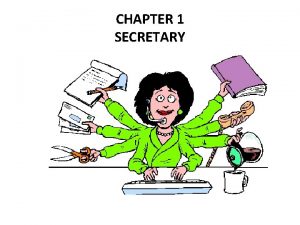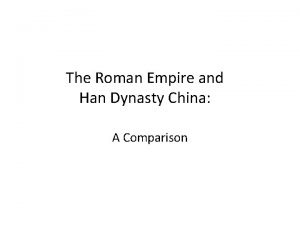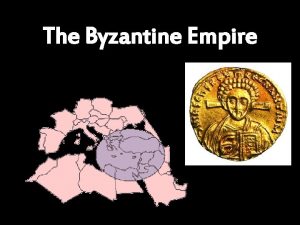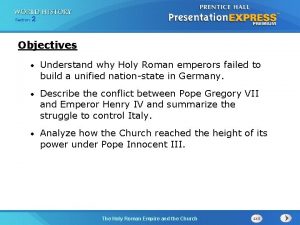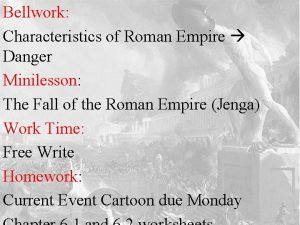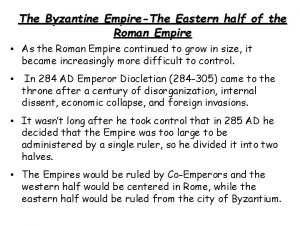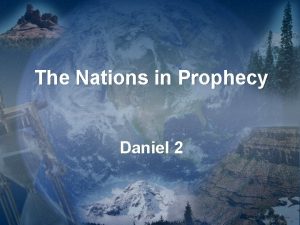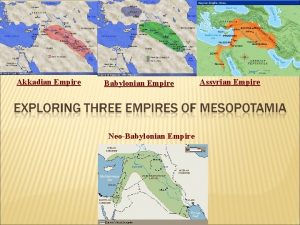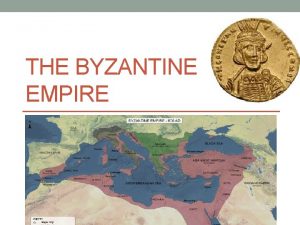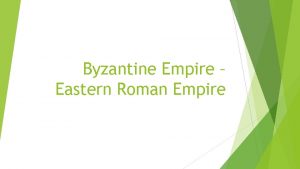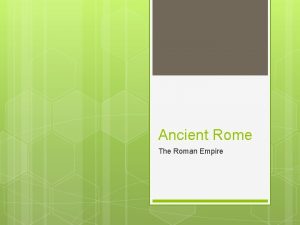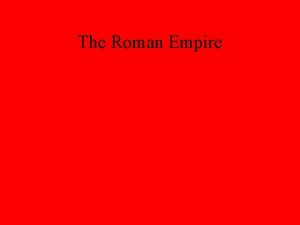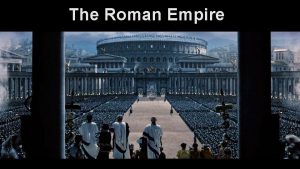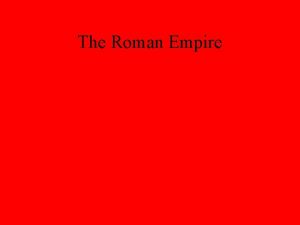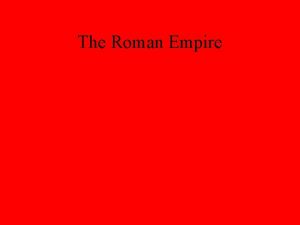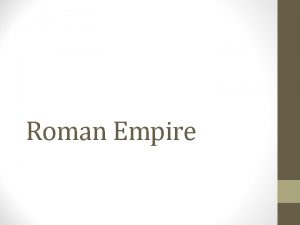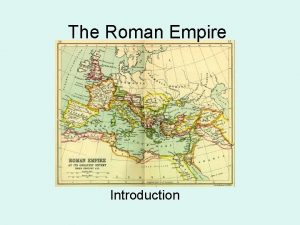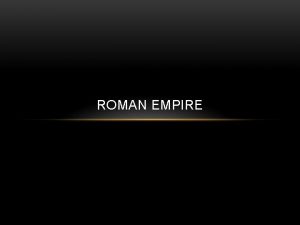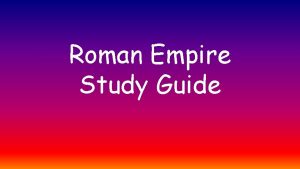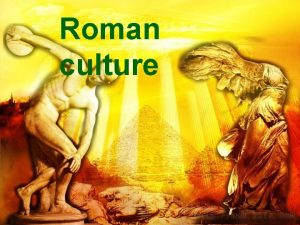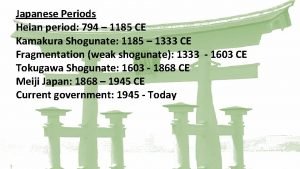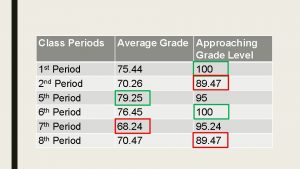Africa Periods 2 6 Period 2 Roman Empire









































- Slides: 41

Africa Periods 2 -6

Period 2 Roman Empire Extends to Northern Africa • Roman empire relied on expansion for slave labor to work in fields • Augustus- Pax Romanacentralized empire with a civil service that managed empire • Political Bureaucracy • Equites- class of Italian merchants who ran empire • Local governors had a lot of freedom • Codified Roman Law Libraries established in Mediterranean • Army built roads throughout region will hold learning of Greeks and empire Romans, and protected by Muslim • Controlled Mediterranean Sea empires, to be rediscovered by Europeans trade during Crusades • Destroyed Carthage • Long borders are hard to defend

Trade Routes beginning in Period 2 • Mediterranean Sea- linked Europe, ME and North Africa ▫ Phoenicians replaced by Greeks ▫ Greeks replaced by Romans • Indian Ocean Route- connected East Asia to India, to ME to Red Sea and Eastern coast of Africa ▫ Dominated by Muslim empires (per 3) who valued trade and merchants & Spread universalizing faith of Islam • Trade Routes across Sahara desert ▫ Introduction of camel (probably from Egypt) made caravans possible �Camel saddle improved caravan ▫ Salt in north traded for kola nuts and palm oil of south • Saharan route connected to Indian Ocean to link China to Sub-Saharan Africa

Trade Routes linking Africa to Asia

• Began around Nigeria (Sub-Saharan -western gold coast) • May have left homeland because of desertification • Gradual migration • Traveled throughout Sub-Saharan Africa spreading ▫ Culture-Bantu Language ▫ Knowledge of agriculture ▫ Use of iron tools (metallurgy) Bantu Migrations Any migrationbe sure to think about the spread of culture

Period 3 -Spread of Islam • Islam began in Middle East and spreads across North Africa ▫ Trading cities of Mecca and Medina linked North Africa to Middle East-origins of camel caravans ▫ Bedouin tribes/nomads of North Africa carried ideas across Africa ▫ Islam replaces animistic faiths of Bedouins • Basic Ideas of Islam ▫ Monotheistic (Like Judaism, Christianity, and Zoroastrianism) ▫ Universalizing Faith�equality of everyone to achieve salvation (like Christianity and Buddhism) �Spread along trade routes ▫ 5 Pillars of Faith- Allah is sole God, alms to poor, pray 5 times per day, fast during Ramadan, pilgrimage to Mecca (Hajj)

Islamic Empires • Political ▫ Caliph is both political and religious leader ▫ Centralized bureaucracy �Vizier is head of bureaucracy �Keep excellent records ▫ Build lavish cities ▫ Collect taxes from non. Muslims ▫ Expanding with jihaddefeating non-Muslim areas • Economic ▫ Support trade and merchants ▫ Control trade routes linking N Africa to East Asia �Used Dhow ships on Indian Ocean • Culture • Spread of culture-esp in yearly pilgrimage to Mecca • Throughout empires elite read and wrote in Arabic aiding in communication and spread of ideas • Est universities (madrasas) • architecture (domes), • Calligraphy • Arabic numerals • Social Hierarchy based on religion

Period 3 -Sub-Saharn Africa • During Period 3 -Islam was the major external contact between Africa and rest of world • Areas develop differently ▫ Sudanic Empires�Mali �Ghana �Songhay ▫ City States along Swahili Coast generally more connected to Indian Ocean trade routes ▫ Sub-Saharan Africa most remote • Common organization-stateless society▫ relies on kinship bonds rather than organized government (like Mongols during nomadic period) ▫ Live in villages of extended families /self sufficient

Trading Empires of West Sudan • Ghana ▫ Large army- but fell to Berbers 13 th century ▫ Trading gold from west Africa for salt and dates from Sahara or goods from Mediterranean coast ▫ Farming was difficult with sandy soil-grew rice, fruits and veggies ▫ Rules were Muslim but commoners were animistic �Muslim leaders helped in trade with Muslim merchants and Muslim nomads controlling caravans ▫ Polygamy common

Trading Empires of West Sudan • Mali ▫ Larger than Ghana �Larger army, larger land area, greater control of west African trade �Caravans linked Mali to north Africa �Timbuktu important trading city �Height of trade under Sundiata’s grand nephew Mansu Musa ▫ Like Ghana-kings were Muslim but commoners animistic �Kings made pilgrimages kept them in touch with Muslim world �Build mosques �Had cosmopolitan court

Trading Empires of West Sudan • Songhay ▫ Niger River valley ▫ Capital Gao ▫ Kings controlled trade �Gao became trading center with large foreign merchant community �Muslims ▫ Defeated 1591 by Morocco with European technology-guns

Trading Empires of West Sudan Ghana, Mali & Songhay-Similarties • Leaders ▫ ▫ Patriarch of controlling family Muslim but commoners animistic Seen as sacred-reinforced by rituals by people control trade • Oral traditions- griots were master storytellers and kept history

Swahili States of East Africa • Economic ▫ Like Western Sudan states- Islamic & connect Africa to trade routes of Islamic empires ▫ Brought gold from interior of Africa (Great Zimbabwe) plus ivory, iron, timber and traded for porcelains, silk, Indian cotton �New trade cities of Mogadishu, Mombasa, Kilwa, & Zanzibar • Culture ▫ Many converted to Islam to make trade easier ▫ Linked by language-Swahili �Swahili based on Bantu but influenced by Arabic (great example of exchange of culture brought by trade!) ▫ Cosmopolitan cities with mosques, plumbing systems, scholars • Political- no central government

Great Zimbabwe • Inland empire-capital Great Zimbabwe was walled • Exported gold to Swahili eastern states • Not Islamic! Ethiopia • Eastern Coast • Christian state but cut off from rest of Christian states so developed independently with African traditions

Cultural Similarities of Period 3 African states • Common vocabulary based on Bantu language allowed some communication among tribes • Animistic religions though many tribal leaders converted to Islam to facilitate trade • Similar rituals of drumming, dancing, rhythm instruments • Wearing masks • Isolation of kings

Period 3 African States

End of Period 3 - Consequences of Interregional Trade Networks • Technological and Agricultural diffusion ▫ Aid travel- compass (China) spread through Indian ocean routes ▫ Gunpowder (China)- by end of period 3 armies using cannons ▫ Diffusion of food- Ex: Africa introduced to citrus and Asian varieties of rice. European introduced to cane sugar • Spread of disease- bubonic plague spreads from China, through Asia, across north Africa and Europe ▫ 60 -70% infected died-huge effect on population especially in cities • Demographic changes ▫ Cities recovered from plague as trade continued in trade centers (Hangzhou, Baghdad, Cairo, Constantinople, Venice & Timbuktu)notice the trade centers are throughout Eurasia and Africa ▫ Now merchants travel whole length of trade routes ▫ Nomads lose power could not replace numbers lost by plague

Period 4 - Age of Exploration 1. China- Zeng He (Ming Dynasty) travels from China to East Asia but no more explorations 2. Portuguese ▫ Conquered Moroccan city and witnessed caravans ▫ Trying to compete with monopoly of trade by Italians and Muslims ▫ Sea Route to India �Prince Henry the Navigator established navigation schools �Used Caravels armed with cannons, compass, astrolabe �Established ports on coast and did not venture into interior of Africa ▫ Treaty of Tordesillas split world between Spain and Portugalorienting Portugal toward Africa and India �As a result, dominated trade with Africa and China during 15 th century


Columbian Exchange- diffusion of plants, animals, and diseases between old and new worlds as a result of Age of Explorations

Continuity of African Slave Trade Map of Period 3 African Slave Trade • Africa had been supplying slaves throughout periods 2 -3 • But historically from north Africa • Women used as domestic labor • Slaves taken to Middle East

Period 4 - African Slave Trade Escalates • Need for labor for New World Plantations after loss of native Amerindians to disease • Change in focus from women to men • Change of location from north Africa to Western Sudan


Mercantilism and Triangle of Trade • Mercantilism- economic system used by Europeans during period 4 in which they tried to achieve a favorable balance of trade by exporting more than they imported ▫ Colonies were required to produce raw materials (Ex: timber, tobacco, fish, sugar, molasses) and markets for finished goods ▫ Cash crops were grown on large plantations requiring huge labor sources—turned to African slavery to fill this labor shortage after natives died • Triangle of trade is the graphic representation of Mercantilism (also known as Great Circuit) ▫ Middle Passage- leg of triangle that slaves forced from Africa to New World colonies

Mercantilism and Triangle of Trade • Mercantilism- economic system used by Europeans during period 4 in which they tried to achieve a favorable balance of trade by exporting more than they imported ▫ Colonies were required to produce raw materials (Ex: timber, tobacco, fish, sugar, molasses) and markets for finished goods ▫ Cash crops were grown on large plantations requiring huge labor sources—turned to African slavery to fill this labor shortage after natives died • Triangle of trade is the graphic representation of Mercantilism (also known as Great Circuit) ▫ Middle Passage- leg of triangle that slaves forced from Africa to New World colonies

Effects of Period 4 African Slave Trade • Economic-wealth ▫ European colonies had self sustaining supply of labor since children born into slavery remained slaves (unlike most earlier periods) ▫ Western African states gained wealth/guns from supply of interior tribes to slavery • Politics- greater instability ▫ Increased tension between African tribes of gold coast-violence grew esp with European guns exchanged for slaves • Culture- exchange ▫ New classes/social hierarchy in New World- complicated system of mixed races especially in Spanish colonies (Ex: Mestizo and Mulatto) ▫ Exchange of culture- African traditions, faiths, languages travel to New World (ALWAYS look for exchange of culture in ANY MIGRATION whether forced or voluntary) ▫ Population shift- African Diaspora �shift from Africa to New World�change in family structure since mostly men sent to New World� but population recovers quickly with healthier diet due to Columbian Exchange esp due to peanuts and cassava

Different results in Africa from Slave Trade • On gold coast-Asante rose with slave trade ▫ Traded in gold, kola nuts ▫ Oyoko clan used guns from Europeans to conquer neighboring tribes ▫ Rich from slave trade • Unlike neighboring Benin which generally stayed out of slave trade favoring trade in ivory, textiles and bronze

Ottomans control part of Northern Africa during part of Period 4 • Ottomans used navy and advanced weaponry to conquer lands around Mediterranean ▫ Lost control of Mediterranean to Spanish at Battle of Lepanto 1571 • Large bureaucracy controlled from Istanbul-led by vizier • Economic problems of inflation from influx of European silver

Period 5 Continuities affecting Africa • World dominated by western powers who led Industrial Revolution • Western nations expand their spheres of influence through Imperialism • Decline of African slave trade • Politically, spread of British parliamentary model of government

Abolitionists movements • Ideas of Enlightenment spread – including extension of ideas to slaves ▫ Social Contract- man should have a role/say in his government- Locke, Hobbes, Montesquieu ▫ Man has natural rights of life, liberty & property-Locke �Declaration of Independence in US (1776) �Declaration of Rights of Many in France (1789) • Abolitionists movements spread ▫ Britain outlawed slavery throughout empire 1833 ▫ US ended slavery with Civil War 1860 s ▫ Brazil last to end slavery-1888 • States relied on new labor systems like indentured servitude

Effects of Imperialism For mother country 1. Wealth from raw materials 2. Political expansion and power by expanding sphere of influence creating global empires 3. Social mobility for those willing to move to colonies 4. Required to spend time and resources putting down revolts For colony 1. Unnatural economy producing one good $$ to mother country 2. Strip environment to produce that one good 3. Mother country built infrastructure to move her goods home (Railroads, canals, communication) 4. Build infrastructure -schools from Social Darwinist ideas 5. Labor migrations- shifts in population leads to exchange of culture 6. Segregated society of natives vs westerners

South Africa • Cape Colony ▫ Dutch established Cape Colony at tip of Africa 1652 and continued to expand ▫ British took Cape Colony from Dutch in Napoleonic wars • 1816 Zulu chief, Shaka, used advanced spears to expand his chiefdom against neighboring tribes ▫ Led to some tribes entering bounds of Cape Colony ▫ Tension between Africans & Boers (Dutch descendants) • 1870 s discovery of diamonds and gold in Cape Colony –raw materials led to new importance for colony ▫ Cecil Rhodes (British) set up companies there ▫ Led to Boer War- Dutch vs English- Total War- English won

Imperialism scramble for Africa (1887) • Berlin Conference • Led by Germany. Otto von Bismarck • Furthering Balance of Power established at Congress of Vienna • European countries could claim Africa if it told rest of Europe • Western nations were expanding their spheres of influence in search of raw and could defend materials and markets area • prior to imperialism west had generally not ventured into interior of Africa

Period 6 - WWI & Treaty of Versailles • WWI▫ Some fighting in Germany colonies in northwestern Africa ▫ Some African colonists participated in fighting of war • Treaty of Versailles (1919)- ended WWI ▫ Goal: punish Germany �Germany paid reparations �Germany took responsibility for war �Limited German military �Germany lost territory including African and Pacific colonies ▫ League of Nations formed as international peace body ▫ All of Germany’s colonies in Africa and Pacific given to Britain, France and Japan as mandates- protectorates (moving away from Nationalism)

Great Depression & Effect on Africa • US- Stock market crash 1929 -global depression follows ▫ US calls in loans to Europe ▫ Protectionist legislation causes many states to isolate trade and protect local goods • Colonies in Africa affected little by Depression because still supplying imperialist countries with raw materials

Period 6 - Decolonization • Decolonization- desire for independence/nationalism • Led by Africans who had been educated in western ideas (Enlightenment)- like South Asia ▫ Natives realized the poor treatment of their fellow countrymen working in mines & fields for imperialists ▫ Organized series of meetings –All-African People’s Conferences • World War II- caused such economic devastation in Great Britain & France that they had to let go of their colonies ▫ prepared their colonies for independence by building infrastructure: hydro-electric power plants, schools, roads ▫ Hoping to preserve positive relationship for trading partners in future

• Ghana first to gain independence (1957) • Nigeria gains independence Decolonization in Sub-Saharan Africa ▫ Great Britain arbitrarily drew lines -joining hostile groups into new nation-long term effect= instability ▫ Like division of India & Pakistanpattern of nationalism • France offers colonies option of independence ▫ Guinea and Djibouti choose independence but many other keep strong ties with France • Belgium did not prepare coloniesled to hostility in Congo turning to civil war British decolonization of Africa

Decolonization-South Africa • By 1980, unique African state- ruled by whites ▫ Dutch (Boer/Afrikaners) and British descent ▫ Apartheid- system of separating races • African National Congress (ANC) organized 1913 to effect change ▫ Led by Nelson Mandela ▫ Supported by United Nations- most nations created sanctions on South Africa- restricting trade and withdrawing economic investments ▫ However, South Africa had many natural resources (gold & diamonds) making sanctions not effective ▫ 1990 Mandela released from prison, 1993 received Nobel Peace Prize, elected president 1994 in first election allowing black South Africans

Decolonization in Northern Africa • Unlike Sub-Saharan Africa, north Africa ▫ had longer contacts with Europe ▫ Part of Muslim heritage but not Arab • Algeria ▫ Islamic nationalism tied to religion rather than statehood ▫ Nationalists fought against those who wanted to remain close to France— fighting caused fall of 4 th Republic in France ▫ Charles de Gaulle started 5 th Republic and negotiated Algerian independence 1962 ▫ 1 million French fled Algeria taking many of the educated ▫ Today- instability with military and Islamic fundamentalism

• Green Revolutioncollection of new agricultural techniques to improve farming efficiency has increased worldwide food production Present day ▫ Use high yield seeds ▫ Expanded use of fertilizer • Green Revolution has not alleviated famines in sub. Saharan Africa. Problems include: ▫ Desertification- Saharan expanding south ▫ Increased population ▫ Hostility and instability in area

Present Day • Status of women: ▫ early marriage, large family norm in most African and Asian societies-limiting ability of women to gain education ▫ Famines hit women harder in patriarchal society when men fed first and better food ▫ High death rate in childbirth ▫ Violence against women in civil wars military tactic
 Ancient rome recreation
Ancient rome recreation Roman republic vs roman empire
Roman republic vs roman empire Cursus honorum
Cursus honorum Periods in roman history
Periods in roman history Venn diagram of mauryan and gupta empires
Venn diagram of mauryan and gupta empires American empire vs british empire
American empire vs british empire Empire building in africa
Empire building in africa Partitioning across africa cloze notes
Partitioning across africa cloze notes Lesson 2 empire building in africa
Lesson 2 empire building in africa Empire building in africa summary
Empire building in africa summary Chapter 25 lesson 1 colonial rule in southeast asia
Chapter 25 lesson 1 colonial rule in southeast asia Roman empire under justinian
Roman empire under justinian Calvinism map
Calvinism map Glory of the roman empire
Glory of the roman empire What are the key achievements from the islamic golden age
What are the key achievements from the islamic golden age Roman empire at its height
Roman empire at its height Roman empire 60 bc
Roman empire 60 bc Youtube egypt
Youtube egypt Dba fanaticus
Dba fanaticus Roman emporor simulator
Roman emporor simulator Chapter 6 section 2 the roman empire
Chapter 6 section 2 the roman empire Empire
Empire The holy roman empire and the church section 2
The holy roman empire and the church section 2 Roman empire 500 bc
Roman empire 500 bc Daily life in the roman city
Daily life in the roman city Positives of the roman empire
Positives of the roman empire West
West French empire
French empire Feudal system definition
Feudal system definition When did the roman empire split
When did the roman empire split What happened after rome fell
What happened after rome fell Eastern half of roman empire
Eastern half of roman empire Pepin the hunchback
Pepin the hunchback Mare nostrum rome
Mare nostrum rome Secretary meaning
Secretary meaning Roman china
Roman china Byzantine empire peak
Byzantine empire peak The holy roman empire and the church section 2
The holy roman empire and the church section 2 Constatntinople
Constatntinople What event marked the fall of rome in 476 c.e.?
What event marked the fall of rome in 476 c.e.? Eastern half of the roman empire
Eastern half of the roman empire Revived roman empire
Revived roman empire
